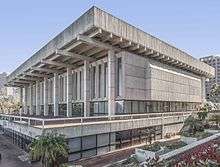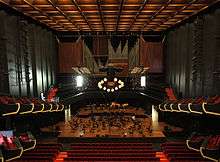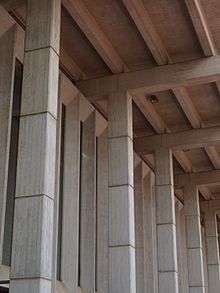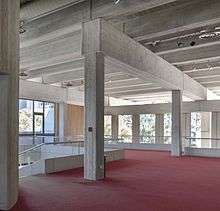Perth Concert Hall (Western Australia)
The Perth Concert Hall is a concert hall located in Perth, the capital of the Australian state of Western Australia. Owned by the City of Perth, the hall is the main venue of the West Australian Symphony Orchestra, and also hosts a number of other events and performances. The building itself is located in Perth's central business district, adjacent to the Supreme Court Gardens and Government House. The building has two façades: facing north over St Georges Terrace, and facing south over the Swan River.
| Perth Concert Hall | |
|---|---|
 | |
%26groups%3D_407948b1eec58ce67dd835b4f79e5e274f60af9c.svg)
| |
| General information | |
| Type | Concert hall |
| Architectural style | Brutalist |
| Town or city | Perth, Western Australia |
| Country | Australia |
| Coordinates | 31°57′29″S 115°51′49″E |
| Current tenants | West Australian Symphony Orchestra Various other events and performances |
| Construction started | 1971 |
| Opened | 26 January 1973 |
| Cost | A$3,201,873 (1973), equivalent to ~A$29 million in 2016[1] |
| Owner | City of Perth |
| Design and construction | |
| Architecture firm | Howlett and Bailey Architects |
| Other information | |
| Seating capacity | 1,729 people (main auditorium) |
| Website | |
| www | |
| Type | State Registered Place |
| Designated | 12 July 2002 |
| Reference no. | 4571 |
The concert hall was constructed on land granted to the City of Perth by the Government of Western Australia, and opened on Australia Day (26 January), 1973. Designed by Howlett and Bailey Architects, local architectural firm, the building is constructed in the Brutalist style, making heavy use of white off-form concrete and a solid opaque interior. The main auditorium of the hall seats 1,729 people, as well as a 160-person choir gallery and a 3000-pipe organ. Acoustically, the venue is considered one of the best in Australia, with the design overseen by the New Zealand acoustician Sir Harold Marshall.
History

As early as 1950, the City of Perth secured a site between Stirling Gardens and Government House, occupied by the Department of Agriculture and the Australian Broadcasting Commission for the construction of a new town hall. The proposed site provoked vigorous public debate. Some wanted a riverside site, such as the Esplanade or Barrack Square, while others suggested land at the end of Barrack Street, between Stirling and Beaufort Streets, or the central Perth area between William and Barrack streets along Forrest Place. The official opening of the Perth Concert Hall included a midnight to dawn ball attended by almost 1,700 people. The Western Australian Symphony Orchestra was joined by 55 members of the South Australian Symphony Orchestra for the occasion, and the whole event was televised. Headlines of ‘A Milestone in the Cultural Life of WA’ greeted the opening. Earlier, John Birman, the Director of the Festival of Perth, had been quoted saying, ‘...it is the first concert hall in Australia since the war and has more than local significance...’.
Chronology of development
- 1950: City of Perth secured land between Stirling Gardens and Government House for the construction of a new town hall.
- 1955: Contest to design new town hall (offices and auditorium) for City of Perth announced.
- 1960: Concept but not design of contest prize winners, Howlett and Bailey, purchased by the City of Perth. The concept was for two separate buildings – a ten-story administrative building and a circular auditorium.
- 1962: Only the administrative block (Council House) was built due to financial constraints and concern over the design of the auditorium.
- 1966: Sir Thomas Wardle sold his Capitol Theatre to the City of Perth to make way for a car park. The Capitol was the main concert venue in Perth and home of the West Australian Symphony Orchestra.
- 1967: State government and the City of Perth formed a special committee to consider the matter of a concert hall. The committee considered ten sites and decided on the abandoned Chevron-Hilton site as the most appropriate. Lengthy negotiations ensued as the City of Perth wanted a combined town hall and concert hall on the site; the State government was not prepared to provide the land and contribute to this – it wanted a concert hall only.
- 1968: City of Perth settled on the construction of a concert hall only and the State Government offered Chevron-Hilton site, $1,000,000 towards construction of a concert hall and 50% of its operating costs. Architects Jefferey Howlett and Don Bailey appointed to design a concert hall in July.
- 1969: The Chevron-Hilton site (Lot 853/Reserve 30347) was vested in the City of Perth for the purpose of the concert hall, public restaurant and parking area. Final plans were presented to the City of Perth in January. The total cost of the project was budgeted at $3.1 million.
- 1970: State Government increased its contribution to the project to $1,350,000 Sabemo awarded the tender of $3,201,873 for construction in April and work on site commenced on 12 June; John Sherwood acted as Project Manager; local companies such as Hollostone Pty Ltd, Midland Brick and Millars Timber provided materials.
- 1972: Construction completed[2] and keys ceremoniously handed over to the manager, Nigel Prescott, in December; at this time, conferences had been booked as far ahead as 1974, and the total bookings for the Hall's first year ‘already exceeded 100’.
- 1973: Official opening and first concert on Australia Day, 26 January. Attended by Prime Minister Gough Whitlam and Mrs Whitlam. This occasion also marked the Festival of Perth's 21st Anniversary Commonwealth Taxation office completed on adjacent site.
- 1980: Perth Theatre Trust formed to bring His Majesty's Theatre and the Perth Concert Hall under a single administration. Other venues, Playhouse Theatre and Subiaco Arts Centre have subsequently included. Perth Concert Hall leased to the Perth Theatre Trust.
- 1982: Completion of work to extend into VIP car park area to provide additional office accommodation (Oldfield Knott Architects).
- 1984: Forecourt landscaped (hobbs Winning Leighton Architects). Commonwealth Family Law Courts constructed on adjacent site to Concert Hall (rear of the Commonwealth Taxation Office).
- 1985: Cooling towers in air conditioning replaced.
- 1987: Small garden and path in north-west corner of site developed by the City of Perth.
- c.1988: Concert Hall re-roofed.
- 1989: New office layout (Cohen and Waller Architects).
- c.1992: Restaurant refurbished; asbestos removed (Palassis Architects).
- 1994: New artists’ facility completed (Palassis Architects).
- 1998: Replacement of air conditioning and relocation of plant to north-east corner of VIP car park.
- 1999: Pedestrian link between Commonwealth Family Law Courts and Concert Hall completed.
- April 2008 – December 2008: Major upgrades to the concrete exterior of the concert hall. This included the installation of scaffolding, cement and concrete works and installation of new exterior lighting. Originally expected to be completed in October 2008, the entire works were finished in early December 2008.[3]
- January 2015: The West Australian Symphony Orchestra become the new venue manager of the Hall.[4]
- 2017: Upgrade of the lighting rig in the Main Auditorium.[5]
- 2018: Upgrade of the venue house lights in the Main Auditorium; upgrade of the venue’s cooling towers and chillers; upgrade to the venue’s facade lighting and upgrade to all front of house toilets
Architectural design



The building was designed by Howlett and Bailey Architects. Jeffrey Howlett and Don Bailey had won a design competition for a Town Hall and auditorium in 1961. Their design consisted of two buildings, one containing administrative offices and the other, oval in shape, comprising the 'town hall' or auditorium. The administration offices, called Council House, were built, however financial constraints and doubts regarding the auditorium's acoustic properties meant that construction of the auditorium building was delayed. Its design was subsequently re-considered and it was not until the late-1960s that a different plan was approved. This plan was
...to accommodate not more than 2,000 people and to cost no more than $2,000,000 and with the highest priority to be given to its musical uses, i.e. Symphony concerts, choral concerts, organ recitals, etc., and, in addition, performances of minimum staged ballet, fold dances or musical drama, and also be suitable for other functions such as large Civic receptions, conferences, conventions, public meetings, pageants, school speech days, pop concerts and folk singers.

Through 1969, the architectural plans were amended several times. These amendments included beautification and landscaping of the main pedestrian approach from St Georges Terrace and construction of a subway under the Terrace, a pit for a 60-piece orchestra with removable flooring and seating to cover the pit when not in use, and improved access and facilities for disabled people. The original plans included a restaurant with a seating capacity for 400, but following inspection of similar halls in the eastern states of Australia, it was decided that this was not warranted. It was, therefore, decided to make the restaurant smaller and include a tavern and cocktail bar, allowing patrons a wider choice. The bar area was named The Wardle Room, after Sir Thomas Wardle.
It was the architects’ intention that the exhibition foyers would be used as a continually changing venue for all types of art (such as painting, tapestry and sculpture exhibitions) rather than as permanent exhibition spaces. This may have influenced the Perth City Council's indecision over whether or not to accept artist Sydney Nolan's offer to permanently loan the City a series of 64 paintings of wildflowers for hanging in the Hall. After considerable public debate over the matter, Nolan withdrew the offer and art dealers and others criticised the short sighted and parochial attitude of the Council in refusing the offer. Ironically, the first exhibition in the foyers featured 54 of Sydney Nolan's wildflower paintings.
Several consultants were involved in the design of the building, including acoustic consultants, structural engineers, and experts in escalators, stage machinery and lighting. D. H. Fraser was responsible for the structural design and Professor A. Harold Marshall was the acoustics consultant, in association with Warwick Mehaffey of the ABC.
Dr Marshall used computer modelling to predict how well people would hear in each of the seats and worked closely with the architects in designing the main auditorium, which according to Jefferey Howlett had to be
...a Great Room, as the Concertgebouw hall in Amsterdam, the Boston Symphony Hall and the Musikvereinsaal in Vienna are great rooms, recognised for their superb acoustic and that is not merely clarity...The great halls have ornate ceilings and other ornamentation. Though the Perth Concert Hall will be a completely modern building, the "fruity" ceilings and decorations of the older halls, which undoubtedly play a part in their acoustics, will be reproduced, in effect, in coffers hanging from the ceiling, in corrugated walls and in the complex double tier of boxes sloping up the side walls.
The Perth Concert Hall is an example of brutalist architecture, with its solid opaque interior, giant projecting roof, and use of white off-form concrete. It forms a counterpoint to the transparent filigree of Council House.[6]
The auditorium features a specially commissioned 3000-pipe organ surrounded by a 160-person choir gallery and an audience seating capacity of 1,729.[7] The organ, individually designed, cost $100,000 and was commissioned by Ronald Sharp of Sydney, who was also responsible for the organ at the Sydney Opera House. The larger pipes for the organ were imported from the Netherlands. Don Bailey recollects that Ron Sharp was an ‘extraordinarily talented person, largely self-educated, who has to his credit the design and construction of a number of organs, mostly in New South Wales. A nine-foot Steinway orchestral concert grand piano (Model D) was also imported from West Germany for installation in the Hall.
The Concert Hall was the first in Australia to have a show relay installed so that latecomers could watch on two screens in the foyer while waiting for an appropriate time to enter. Another screen is located at Stage Door.
The Perth City Council and State Government, as well as the architects and builders, received many compliments on the Hall as it neared completion from visiting experts in the fields of music, architecture and construction.
Operations
The Perth Concert Hall has been described as one of the best fine music acoustics venues in Australia.[7] It has played host to a diverse selection of internationally acclaimed performers including the London Philharmonic, Chicago Symphony, Israel Philharmonic and contemporary performers B.B. King, Sting, k.d. lang, Harry Connick, Jr., Melissa Etheridge, Ray Charles, Rowan Atkinson and Billy Connolly.[7]
The majority of concerts by the West Australian Symphony Orchestra are performed at the Perth Concert Hall. The venue is also used for their rehearsals.
The venue is also used to host national conventions and exhibitions, award ceremonies and gala dinners. Recent exhibitions include the Steinway piano exhibition in March 2008. In addition, the venue is used for private or corporate functions in areas other than the auditorium, for example in the foyers, bar and café.
Association with Perth Concert Hall, Scotland
On 27 September 2006 the Perth Concert Hall participated in a twinning ceremony and the signing of Mutual Understanding with the Perth Concert Hall, Scotland. As a result of this twinning the Concert Hall now flies the St Andrews Flag at the front of the venue to commemorate the twinning.
Gallery
See also
References
- "Inflation Calculator". RBA. 14 February 1966. Retrieved 10 March 2017.
- The Master builder Perth Concert Hall supplement. Perth, W.A.Master Builder, 1972. Supplement to the Master builder, November 1972.
- "Perth Concert Hall : History". AEG Ogden. Archived from the original on 25 November 2012. Retrieved 12 November 2012.
- "Perth Concert Hall : News". Perth Concert Hall. Retrieved 30 October 2017.
- "Jands - Perth Concert Hall shines bright with upgrade". Jands. Retrieved 30 October 2017.
- AA – Obituary – March/April 2006 Archived 31 July 2008 at the Wayback Machine
- Perth Concert Hall Web Site Archived 1 August 2001 at the Wayback Machine
| Wikimedia Commons has media related to Perth Concert Hall, Western Australia. |
Further reading
- Gregory, Jenny (2003) City of light : a history of Perth since the 1950s Perth, W.A. : City of Perth. ISBN 0-9594632-4-0 (pbk.) pp. 172–8.



